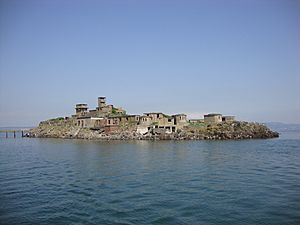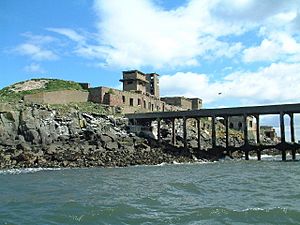Inchmickery facts for kids
Inchmickery is a small island located in the Firth of Forth, a large bay on the east coast of Scotland. It's about 2 miles (3.2 km) north of Edinburgh, Scotland's capital city.
What's in a Name?
The name Inchmickery comes from the Scottish Gaelic words Innis nam Biocaire. This means "Isle of the Vicars." A "vicar" is a type of church leader. This name suggests that there might have been an old church settlement or religious community on the island a long time ago, similar to the nearby island of Inchcolm.
The name "Inch" (Innis) is also a Gaelic word for island. This sometimes leads to a fun riddle: "How many inches is the Forth?" It plays on the word "inch" as a measurement and "Inch" as an island name.
Island History
Inchmickery is quite small, only about 100 meters (328 feet) long and 200 meters (656 feet) wide. Despite its size, it played an important role during both World War I and World War II. During these wars, the island was used as a place to set up large guns to defend the area.
The concrete buildings built for these guns make the island look like a battleship from a distance! Even though no one lives on Inchmickery today, many of these strong concrete structures are still standing.
Wildlife Haven
Today, Inchmickery is a special nature reserve managed by the RSPB (Royal Society for the Protection of Birds). It's a safe home for many different types of birds.
- Common Eider: These are large sea ducks known for their soft feathers.
- Sandwich Terns: These are seabirds that dive into the water to catch fish.
- Various Gulls: Many kinds of gulls also nest and live on the island.
Inchmickery used to be a nesting spot for a very rare bird called the roseate tern. However, these terns have now moved to other places within the Firth of Forth.
Off the coast of Inchmickery, there are some exposed rocks known as the "Cow & Calves." These rocks are also part of the island's natural landscape.
Past Uses
In the past, Inchmickery was well-known for its oyster-beds. Oysters are shellfish that live in the sea. The island was also once covered in moss and lichen, which are small plant-like growths.



